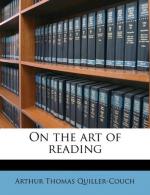And yet, may be, “The Pall Mall Gazette” was on the right scent. For it was in search of masterpieces: and, however we teach, our trust will in the end repose upon masterpieces, upon the great classics of whatever Language or Literature we are handling: and these, in any language are neither enormous in number and mass, nor extraordinarily difficult to detect, nor (best of all) forbidding to the reader by reason of their own difficulty. Upon a selected few of these—even upon three, or two, or one—we may teach at least a surmise of the true delight, and may be some measure of taste whereby our pupil will, by an inner guide, be warned to choose the better and reject the worse when we turn him loose to read for himself.
To this use of masterpieces I shall devote my final lecture.
[Footnote 1: Charles Reade notes this in “The Cloister and the Hearth,” chap. LXI.]
[Footnote 2: The loose and tautologous style of this Preface is worth noting. Likely enough Browne wrote it in a passion that deprived him of his habitual self-command. One phrase alone reveals the true Browne—that is, Browne true to himself: ’and time that brings other things to light, should have satisfied me in the remedy of its oblivion.’]
LECTURE XII
ON THE USE OF MASTERPIECES
WEDNESDAY, NOVEMBER 6, 1918
I
I do not think, Gentlemen, that we need to bother ourselves today with any definition of a ‘classic,’ or of the stigmata by which a true classic can be recognised. Sainte-Beuve once indicated these in a famous discourse, “Qu’est-ce qu’un classique”: and it may suffice us that these include Universality and Permanence. Your true classic is universal, in that it appeals to the catholic mind of man. It is doubly permanent: for it remains significant, or acquires a new significance, after the age for which it was written and the conditions under which it was written, have passed away; and it yet keeps, undefaced by handling, the original noble imprint of the mind that first minted it—or shall we say that, as generation after generation rings the coin, it ever returns the echo of its father-spirit?
But for our purpose it suffices that in our literature we possess a number of works to which the title of classic cannot be refused. So let us confine ourselves to these, and to the question, How to use them?
II
Well, to begin with, I revert to a point which I tried to establish in my first lecture; and insist with all my strength that the first obligation we owe to any classic, and to those whom we teach, and to ourselves, is to treat it absolutely: not for any secondary or derivative purpose, or purpose recommended as useful by any manual: but at first solely to interpret the meaning which its author intended: that in short we should trust any given masterpiece for its operation, on ourselves and on others. In that first lecture I quoted to you this most wise sentence:




